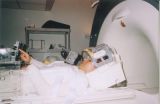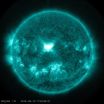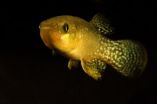(Press-News.org) TORONTO, Sept. 10, 2014 - Serena Williams won her third consecutive US Open title a few days ago, thanks to reasons including obvious ones like physical strength and endurance. But how much did her brain and its egocentric and allocentric functions help the American tennis star retain the cup?
Quite significantly, according to York University neuroscience researchers whose recent study shows that different regions of the brain help to visually locate objects relative to one's own body (self-centred or egocentric) and those relative to external visual landmarks (world-centred or allocentric).
"The current study shows how the brain encodes allocentric and egocentric space in different ways during activities that involve manual aiming," explains Distinguished Research Professor Doug Crawford, in the Department of Psychology. "Take tennis for example. Allocentric brain areas could help aim the ball toward the opponent's weak side of play, whereas the egocentric areas would make sure your muscles return the serve in the right direction."
The study finding will help healthcare providers to develop therapeutic treatment for patients with brain damage in these two areas, according to the neuroscientists at York Centre for Vision Research.
"As a neurologist, I am excited by the finding because it provides clues for doctors and therapists how they might design different therapeutic approaches," says Ying Chen, lead researcher and PhD candidate in the School of Kinesiology and Health Science.
The study, Allocentric versus Egocentric Representation of Remembered Reach Targets in Human Cortex, published in the Journal of Neuroscience, was conducted using the state-of-the-art fMRI scanner at York U's Sherman Health Science Research Centre. A dozen participants were tested using the scanner, which Chen modified to distinguish brain areas relating to these two functions.
The participants were given three different tasks to complete when viewing remembered visual targets: egocentric reach (remembering absolute target location), allocentric reach (remembering target location relative to a visual landmark) and a nonspatial control, colour report (reporting color of target).
When participants remembered egocentric targets' locations, areas in the upper occipital lobe (at the back of the brain) encoded visual direction. In contrast, lower areas of the occipital and temporal lobes encoded object direction relative to other visual landmarks. In both cases, the parietal and frontal cortex (near the top of the brain) coded reach direction during the movement.
INFORMATION:
Note: Click here for an image of the state-of-the-art fMRI scanner at York U's Sherman Health Science Research Centre, modified for this research.
York University is helping to shape the global thinkers and thinking that will define tomorrow. York U's unwavering commitment to excellence reflects a rich diversity of perspectives and a strong sense of social responsibility that sets us apart. A York U degree empowers graduates to thrive in the world and achieve their life goals through a rigorous academic foundation balanced by real-world experiential education. As a globally recognized research centre, York U is fully engaged in the critical discussions that lead to innovative solutions to the most pressing local and global social challenges. York U's 11 faculties and 27 research centres are thinking bigger, broader and more globally, partnering with 288 leading universities worldwide. York U's community is strong − 55,000 students, 7,000 faculty and staff, and more than 250,000 alumni.
Media Contact: Gloria Suhasini, Media Relations, York University, 416 736 2100 x 22094, suhasini@yorku.ca
York U neuroscientists decode brain maps to discover how we take aim
The study finding will help health-care providers to develop therapeutic treatment for patients with brain damage in these 2 areas, according to the neuroscientists at York Centre for Vision Research
2014-09-10
ELSE PRESS RELEASES FROM THIS DATE:
Happy Camp Fire in California and 790 Fire in Oregon
2014-09-10
The 790 Fire in Oregon began as a lightning strike on July 31, 2014. Over 3,000 acres have been affected by this fire which is 54% contained. In the next 12 to 48 hours there is a potential risk to Sky Lakes Wilderness and natural resources including the Northern Spotted Owl habitat, Coho habitat, water quality, the Pacific Crest Trail, and Cherry Creek Research Natural Area. Area and trail closures exist on the Pacific Crest Trail. The weather is not helping the fire fighters with gusty winds and low relative humidity. The operational objectives include keeping the ...
Diverse neighborhoods may help infants' social learning
2014-09-10
Experiencing diverse communities by hearing different languages at the park, on a bus or in the grocery store may make babies more open-minded in their social learning, a new study finds.
While previous research has shown that direct interactions with parents and caregivers shape early cognitive development, the influence of the broader community beyond those direct experiences has not been as carefully examined. In a new study published by the journal Cognition, University of Chicago Psychology Department researchers investigated whether the variety of languages in infants' ...
Will the real unemployment rate please stand up?
2014-09-10
PRINCETON, N.J.—America's unemployment rate — most recently reported as 6.1 percent — has long been used to gauge the country's economic well-being. But a new working paper released by Princeton University's Woodrow Wilson School of Public and International Affairs highlights the difficulty in estimating the exact unemployment rate, though changes in the official measure still signal important movements in the economy.
The research, published by the National Bureau of Economic Research, finds that the true unemployment rate may be higher or lower than recent reports ...
Sequencing and analysis of gibbon genome sheds light on its complex evolution
2014-09-10
PORTLAND, Ore. — A team led by an Oregon Health & Science University researcher has sequenced and annotated the genome of the only ape whose DNA had yet to be sequenced — the gibbon, an endangered small ape that inhabits the tropical forests of Southeast Asia.
The team's work, published in the Sept. 11 edition of Nature, gives scientists new insight into the evolution of the gibbon genome and its extraordinary number of chromosomal rearrangements. Chromosomal rearrangements are structural changes in the DNA that are often problematic in other species — including causing ...
Gibbon genome and the fast karyotype evolution of small apes
2014-09-10
BATON ROUGE – LSU's Mark Batzer, LSU Boyd Professor and Dr. Mary Lou Applewhite Distinguished Professor, along with Research Assistant Professor Miriam Konkel and Research Associate Jerilyn Walker in Department of Biological Sciences in the College of Science, contributed to an article featured on the cover of the scientific journal Nature, titled "Gibbon Genome and the Fast Karyotype Evolution of Small Apes."
An abstract of the article can be found at http://www.nature.com/nature/journal/v513/n7517/full/nature13679.html?WT.ec_id=NATURE-20140911. The issue of Nature will ...
NASA sees a significant flare surge off the sun
2014-09-10
The sun emitted a significant solar flare, peaking at 1:48 p.m. EDT on Sept. 10, 2014. NASA's Solar Dynamics Observatory captured images of the event.
Solar flares are powerful bursts of radiation. Harmful radiation from a flare cannot pass through Earth's atmosphere to physically affect humans on the ground. However -- when intense enough -- they can disturb the atmosphere in the layer where GPS and communications signals travel.
To see how this event may affect Earth, please visit NOAA's Space Weather Prediction Center at http://spaceweather.gov, the U.S. government's ...
Study provides more evidence that sleep apnea is hurting your brain
2014-09-10
Employing a measure rarely used in sleep apnea studies, researchers at the UCLA School of Nursing have uncovered evidence of what may be damaging the brain in people with the sleep disorder — weaker brain blood flow.
In the study, published Aug. 28 in the peer-reviewed journal PLOS ONE, researchers measured blood flow in the brain using a non-invasive MRI procedure: the global blood volume and oxygen dependent (BOLD) signal. This method is usually used to observe brain activity. Because previous research showed that poor regulation of blood in the brain might be a problem ...
Sharks more abundant on healthy coral reefs
2014-09-10
Sharks in no-fishing zones in the Great Barrier Reef (GBR) Marine Park are more abundant when the coral is healthy, according to a study published September 10, 2014 in the open-access journal PLOS ONE by Mario Espinoza from James Cook University, Australia and colleagues.
Shark species that use coral reefs may be under pressure from fishing, habitat degradation, and climate change. The authors of this study were interested in understanding the factors that affect the distribution and abundance of shark populations in the GBR, including fishing and habitat quality. To ...
Gulf killifishes' biological responses to oil spills similar in field, laboratory studies
2014-09-10
Gulf killifish biological responses to the Deepwater Horizon oil spill detected by researchers in the field are similar to those in controlled laboratory studies, according to a study published September 10, 2014 in the open-access journal PLOS ONE by Whitney Pilcher from Louisiana State University and colleagues.
After the Deepwater Horizon oil spill, scientists monitored the impacts of oil on a local species of fish, the Gulf killifish. Changes in genome expression responses to oil exposure may provide insight into how the fish are affected by or adapt to environmental ...
New study shows impact of movies on dog breed popularity
2014-09-10
The effect of movies featuring dogs on the popularity of dog breeds can last up to ten years and is correlated with the general success of the movies, according to new research from the University of Bristol, the City University of New York, and Western Carolina University.
The study, published today in PLOS ONE, also found that movies' influence was strongest in the early twentieth century and has declined since.
The researchers used data from the American Kennel Club, which maintains the world's largest dog registry totalling over 65 million dogs, and analysed a total ...
LAST 30 PRESS RELEASES:
Heart-brain connection: international study reveals the role of the vagus nerve in keeping the heart young
Researchers identify Rb1 as a predictive biomarker for a new therapeutic strategy in some breast cancers
Survey reveals ethical gaps slowing AI adoption in pediatric surgery
Stimulant ADHD medications work differently than thought
AI overestimates how smart people are, according to HSE economists
HSE researchers create genome-wide map of quadruplexes
Scientists boost cell "powerhouses" to burn more calories
Automatic label checking: The missing step in making reliable medical AI
Low daily alcohol intake linked to 50% heightened mouth cancer risk in India
American Meteorological Society announces Rick Spinrad as 2026 President-Elect
Biomass-based carbon capture spotlighted in newly released global climate webinar recording
Illuminating invisible nano pollutants: advanced bioimaging tracks the full journey of emerging nanoscale contaminants in living systems
How does age affect recovery from spinal cord injury?
Novel AI tool offers prognosis for patients with head and neck cancer
Fathers’ microplastic exposure tied to their children’s metabolic problems
Research validates laboratory model for studying high-grade serous ovarian cancer
SIR 2026 delivers transformative breakthroughs in minimally invasive medicine to improve patient care
Stem Cell Reports most downloaded papers of 2025 highlight the breadth and impact of stem cell research
Oxford-led study estimates NHS spends around 3% of its primary and secondary care budget on the health impacts of heat and cold in England
A researcher’s long quest leads to a smart composite breakthrough
Urban wild bees act as “microbial sensors” of city health.
New study finds where you live affects recovery after a hip fracture
Forecasting the impact of fully automated vehicle adoption on US road traffic injuries
Alcohol-related hospitalizations from 2016 to 2022
Semaglutide and hospitalizations in patients with obesity and established cardiovascular disease
Researchers ‘listen in’ to embryo-mother interactions during implantation using a culture system replicating the womb lining
How changing your diet could help save the world
How to make AI truly scalable and reliable for real-time traffic assignment?
Beyond fragmented markets: A new framework for efficient and stable ride-pooling
Can shape priors make road perception more reliable for autonomous driving?
[Press-News.org] York U neuroscientists decode brain maps to discover how we take aimThe study finding will help health-care providers to develop therapeutic treatment for patients with brain damage in these 2 areas, according to the neuroscientists at York Centre for Vision Research





